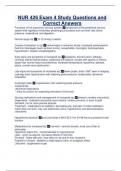NUR 426 Exam 4 Study Questions and
Correct Answers
Functions of the autonomic nervous system ✅component of the peripheral nervous
system that regulates involuntary physiologic processes such as heart rate, blood
pressure, respirations, and digestion
Normal range icp ✅10-15 mmhg in adults
Causes of elevation in icp ✅hemorrhagic or ischemic stroke, increased cerebrospinal
fluid from blockages (such as brain tumor), encephalitis, meningitis, hydrocephalus,
hypertension, hepatic encephalopathy
Early signs and symptoms of increased icp ✅headache, blurred vision, lethargy,
vomiting, altered mental status, weakness (off balance, trouble with speech or vision),
larger than normal head circumference, increased temperature, dysarthria, aphasia,
ataxia, cranial nerve dysfunction
Late signs and symptoms of increased icp ✅blown pupils, brain "shift" seen in imaging,
cushings triad, hypertension with widening pulse pressure, bradycardia, abnormal
respiration
Cushings triade ✅-hypertension with widening pulse pressure
-bradycardia
-abnormal respirations
- there is concern for impending herniation of the brain
Nursing implications and management of increased icp ✅airway is number one priority
Diagnostics - extensive and serial neuro checks, lumbar puncture, ct scan is gold
standard, mri for more precise pictures
Treatment - medications for sedation, decreasing icp, and pain; if initial medication
mgmt does not work, may use barbiturate coma, hypothermia, and decompressive
craniotomy
Hypothermia protocol ✅goal core temp is 89.6-93.2 f for 24-48 hours to preserve brain
function
Medications for increased icp ✅mannitol - osmotic diuretic; must use a filter to
administer
Hypertonic saline 3% - contraindicated in hyponatremia
Lasix - given as adjunct, increases effects of mannitol
Fentanyl - helps with pain, less effect on bp and hr than morphine
Propofol or versed - sedative to help keep pt calm, no analgesic effect
Lidocaine - suppresses cough
,Side effects of mannitol ✅extravasation of iv site can cause compartment syndrome
Hypervolemia
Electrolyte disturbances
Nephrotoxicity
Side effects of hypertonic saline 3% ✅hemolysis - give with d5w/nacl 0.2% or nacl
0.45%
Sodium toxicity can occur is rate of correction is too fast (can lead to seizures, then
death)
Side effects of lasix ✅hypokalemia, hypomagnesemia, hypocalcemia, hyponatremia,
headache, dizziness (low bp)
Side effects of fentanyl ✅decreased respiratory rate and depth (respiratory
depression)
Constricted pupils
Dizziness
Urinary retention
Side effects of propofol or versed ✅orthostatic hypotension
Blurred vision
Fast, slow, or irregular heartbeat
Headache
Side effects of lidocaine ✅drowsiness, dizziness, hypotension, bradycardia, bradypnea
Nursing interventions for increased icp ✅-keep hob at 30-45 degrees and head and
spine in alignment
-assess for fluid overload
-assess neuro status q 1 hr and prn including pupil response
-teach pt to avoid cough, blowing nose, valsalva maneuvers
-seizure precautions
-frequent temp checks, temp can increase
-assess for babinski reflex and posturing
-avoid cns depression meds in beginning (can alter mental status)
-strict i and o
-monitor electrolytes (na can increase w meds, increases seizure potential)
-decrease stimuli in room (quiet environment, low lights)
-avoid clustering care, do one thing then let rest
-hyperoxygenate prior to suctioning and monitor airway to prevent unnecessary
coughing, keep sat at 95 and up
Difference between decorticate and decerebrate posturing ✅decorticate has hands up,
decerebrate has hands at sides
, Hemorrhagic stroke ✅bleeding
Ischemic stroke ✅clot - approximately 87% of strokes
Tia (transient ischemia stroke) ✅mini stroke - treat the same as a ischemic stroke, but
outside of tpa window; looks like a stroke but gets better on its own
Risk factors to stroke ✅a-fib, high cholesterol, heart valve disease, post mi,
endocarditis, hypertension, cocaine use, smoking, diabetes, obesity, genetics, use of
oral contraceptives in women (increases risks of all clots)
Abcs of education stroke ✅aspirin use when appropriate
Blood pressure control
Cholesterol management
Smoking cessation
Signs and symptoms of stroke ✅fast mnemonic (face drooping, arm weakness,
speech difficulty, time to call 911)
Trouble with balance, difficulty speaking, one sided facial droop, altered mental status,
numbness or altered sensation, headache, dizziness, unresponsive or collapse,
symptoms are on one side
Important history questions regarding stroke ✅last known well (lkw) - when did the
symptoms start
Medications - thinners, bp meds, do they take them
What were you doing when the symptoms started
How did the symptoms progress - have they improved
Medical hx - hx of stroke, recent bleeding, a fib, tbi, drug use
Do you have a headache - is it the worst headache of your life
Why do you need a blood sugar and weight on a stroke pt ✅need a blood sugar before
calling a stroke alert because low blood sugar can mimic a stroke
Need an accurate weight for in case of tpa administration
What scan is needed for a stroke pt ✅ct because it is fast, mri takes a while, but may
be useful in finding a smaller clot (clearer images)
Cta - ct angio, helps determine where the clot or bleed is, uses contrast, assess for
allergy and kidney disease
What is the time goal for a stroke pt ✅from recognition, door to ct in 10 minutes
Door to cta in 25 minutes, nationwide standard
Tpa ✅tissue plasminogen activator, alteplase, gold standard "clot buster"
Must be administered within 3-4.5 hours of lkw




